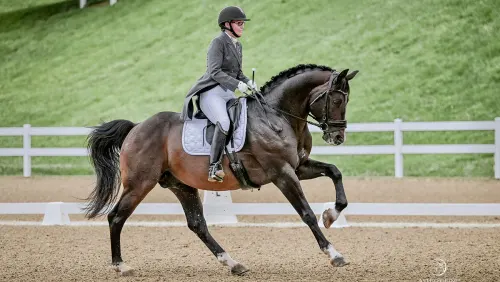While most equestrian enthusiasts know the Spanish Riding School in Vienna is a place dedicated to classical dressage, until now that education has only been available to a select few. For the outside world the SRS has mainly been a tourist attraction—a place to see the famous Lippizans.
The riders and officials at the SRS have also considered demonstrations to be their primary role in recent years. Riders who worked at the SRS weren’t tasked with passing on their knowledge of horsemanship and the training of classical dressage as part of their official duties, although many did so in their leisure time or after leaving. This was the case for George Wahl, a former member of the SRS and trainer of Olympic individual gold medalist Christine Stueckelberger. It was also true for Ernst Hoyos, the former trainer of 2004 Olympic team dressage bronze medalist Lisa Wilcox.
But starting in the spring of 2013, this will change. “Oberbereiter Andreas Hausberger, the director of the Training Center Heldenberg in Austria, has developed a concept that will bring the knowledge about the high school of the classical art of riding closer to the international equestrian world,” said Elisabeth Guertler, the general director of the Spanish Riding School in Vienna.
The new educational program will include
- One- to five-day theory seminars
- Riding lessons for upper-level riders with their own horses, focusing on the collected movements, piaffe and passage
- Learning to work with long reins and the airs above the ground
- Seminars for dressage judges and other international experts
- Seminars for the further training for professional riders and trainers by the Austrian federation
- An educational program for grooms
Organizers expect that riders will bring their own horses, but for those who cannot, leasing horses from other local stables may be possible.
In 2005, the summer quarters of the Lipizzan stallions of the SRS moved from the Lainz Animal Park to Heldenberg, about 45 minutes away by car. The 8-acre facility includes a new barn, built specifically for the stallions, containing 81 stalls with individual paddocks, as well as riding arenas and an indoor longing area. An indoor arena was also added two years ago to complete the training center.
The area around Heldenberg—which includes the burial site and a monument to Joseph Radetzky von Radetz (an Austrian general immortalized by Johann Strauss I’s “Radetzky March”), a palace with an English Garden and an automobile museum—covers about 265 acres and offers many open fields in which to hack horses.
During the SRS’s two-month summer stay at Heldenberg, Lippizan stallions occupy most of the 81 stalls. The rest of the year, only half of the stalls are used by the SRS stallions, which come to Heldenberg with their riders twice a year for a six-week vacation from life in the big city. The facility also houses sales horses from Piber, the stud farm linked to the SRS, where the Lipizzans are bred. In the future, the other 40 stalls will be filled by horses there for training, or by those belonging to participants in the clinics and seminars.
ADVERTISEMENT
Peter Steinbach, the mayor of Heldenberg (population 1,500) and manager of the marketing and governing body of the Heldenberg property, has already seen the presence of the SRS benefit the community and the region. He noted that the thrice-weekly opportunities for spectators to watch the riders in their daily work and an annual gala event that takes place in the outdoor arena next to the palace have increased the area’s name recognition.
“Especially the vineyards and the restaurants of this region have profited,” he said. “For the future, we want to enlarge the accommodation capacity at Heldenberg and to improve the connection to the public transport system.”
Requests for riding lessons have already come from places as far away as Turkmenistan, the United States and South Africa. The Cadre Noir in France, one of four training centers where the high school and airs above the ground are still taught, wants to send a young lady to Heldenberg, according to Guertler, to deepen her knowledge about working horses in long reins.
“The lessons in German, English and French are included in the price, but for other languages, the participants have to bring the own translator or have to hire one here at their own expense,” said Guertler.
Hausberger has spent the last 14 years teaching clinics in the United States. He began in Monterey, Calif., at Grand Prix rider and dressage judge Jennifer Roth’s facility, where he continues to give clinics from young horse to Grand Prix level. More recently he added clinics in Seattle, Santa Fe, N.M.; and New Berlin, N.Y. He also recently became the senior advisor of the U.S. Lipizzan Federation. The USLF plans to bring interested breeders and riders to Heldenberg for seminars.
The costs for theory seminars vary depending on the exact program, but the prices for riding lessons with a rider’s own horse are fixed: individual 45-minute lessons will cost 250 euro; 60-minute group lessons of no more than three riders will cost 150 euro per rider. Board for one’s horse at Heldenberg will be 50 euro per day, including all services.
Detailed information can be found on www.srs.at/en/training/. To participate in riding lessons, a video showing the capability of horse and rider is required.














